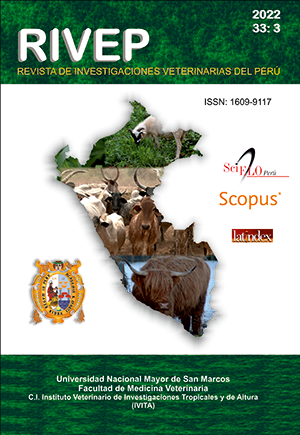Factors affecting pregnancy rate in recipients of embryos produced in vitro under high altitude conditions
DOI:
https://doi.org/10.15381/rivep.v33i3.22897Keywords:
embryo, embryo transfer, in vitro, pregnancy, high altitudeAbstract
The aim of this study was to determine the factors that affect pregnancy in recipient females of embryos produced in vitro under high altitude conditions. The study was carried out at the Universidad Nacional del Altiplano (UNA), located in Puno, Peru, at an altitude of 3970 m. 50 recipient females (nulliparous, primiparous and multiparous) Brown Swiss were used. Ovaries were collected from cows at a local slaughterhouse and taken to the UNA animal reproduction laboratory, where the oocytes were collected, and in vitro maturation and fertilization, culture and embryo evaluation were carried out. The transport time to the laboratory was 2 to 3 h. Quantitative factors such as body condition score (CC), diameter of the corpus luteum (CL) and number of parities, and qualitative factors such as the place of deposit of the embryo (right or left horn) and embryo quality, were evaluated using the Wilcoxon and Chi test. square, respectively. Likewise, a binary logistic regression was applied to study all the factors together. The highest pregnancy rate occurred when the recipients had a 2.65 CC, 19.54 mm CL diameter and in primiparous as quantitative factors and when transferred to the left ipsilateral horn (9/12) with grade 1 embryos (G1: 11/ 17) as qualitative factors. However, the binary logistic regression model did not determine significance as a whole.
Downloads
Downloads
Published
Issue
Section
License
Copyright (c) 2022 Manuel Guido Pérez Durand, Teófilo Béjar Huaylla, Yesenia María Quispe Barriga, Eliseo Pelagio Fernández Ruelas, María Antonieta Flores Guillen, Alfredo Delgado Castro, Uri Harold Pérez Guerra

This work is licensed under a Creative Commons Attribution 4.0 International License.
AUTHORS RETAIN THEIR RIGHTS:
a. Authors retain their trade mark rights and patent, and also on any process or procedure described in the article.
b. Authors retain their right to share, copy, distribute, perform and publicly communicate their article (eg, to place their article in an institutional repository or publish it in a book), with an acknowledgment of its initial publication in the Revista de Investigaciones Veterinarias del Perú (RIVEP).
c. Authors retain theirs right to make a subsequent publication of their work, to use the article or any part thereof (eg a compilation of his papers, lecture notes, thesis, or a book), always indicating the source of publication (the originator of the work, journal, volume, number and date).










